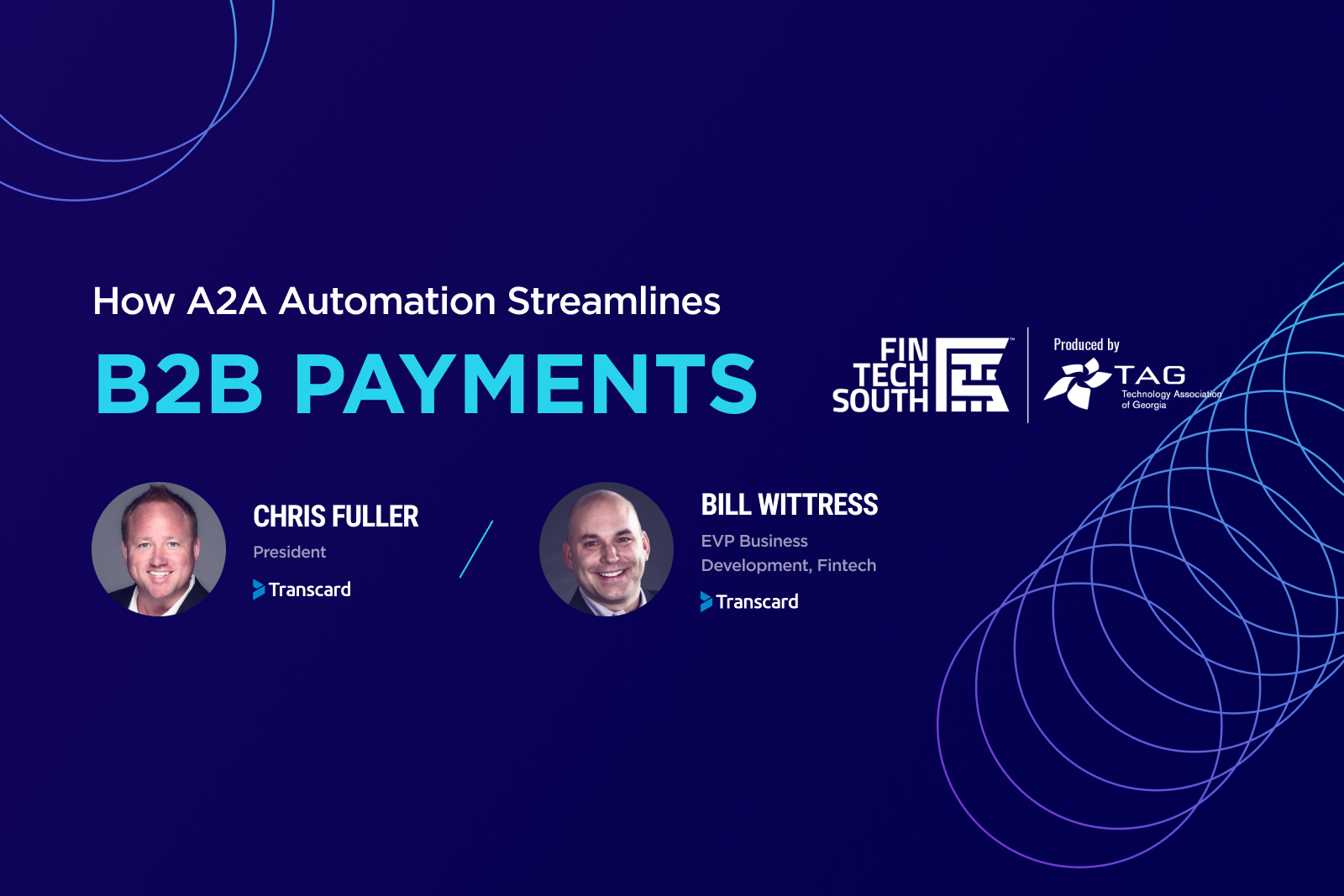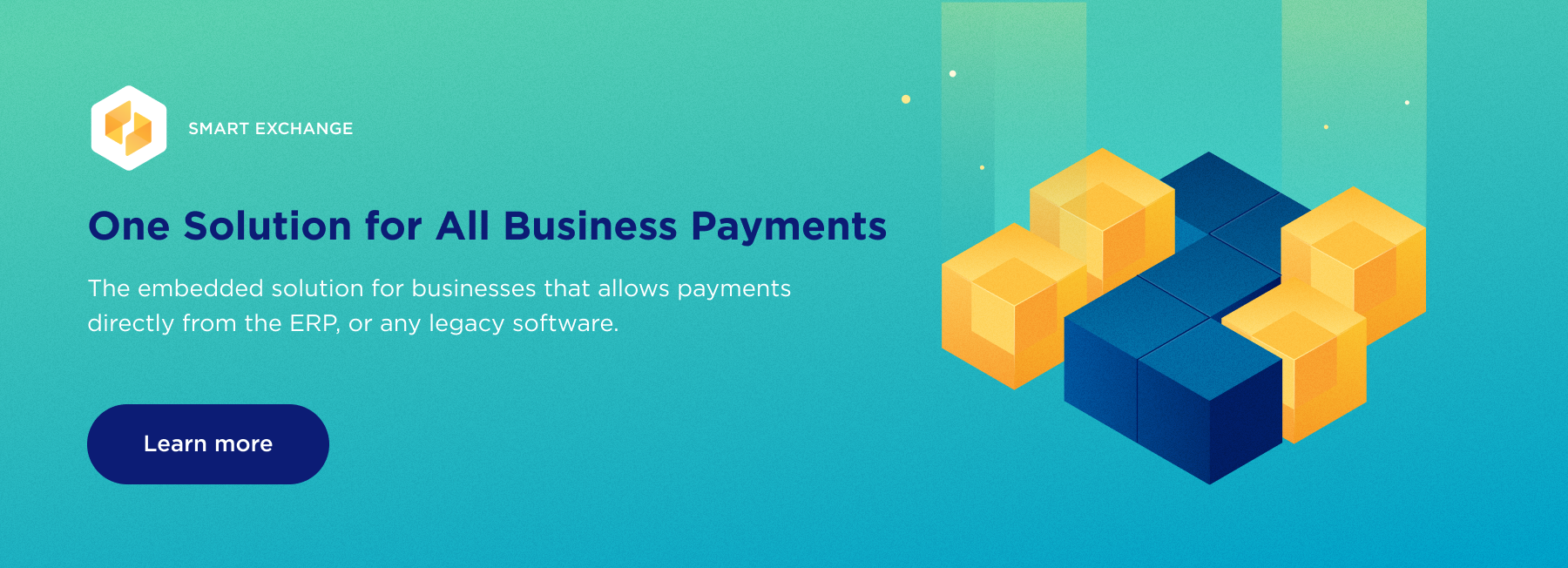The shift to remote working and economic downturn has created new challenges in the way that business gets done. This is especially true when it comes to B2B payments.
Shortcomings in the way that businesses have traditionally made and received payments from suppliers and customers have been exposed and exacerbated over the past year.
The Result?
Many businesses and banks are wondering what the best approach is for automating their payments, how they should use emerging technologies, and what role banks and fintechs should play in it all.
That was the focus of a Fintech South 2021 virtual panel discussion titled, That’s AOK: How Account-to-Account Automation Streamlines B2B Payments and Delivers value for all Parties.
The panel was sponsored by Transcard and included representatives from Mastercard, Fifth Third Bank, and SAP. Transcard Executive Vice President Bill Wittress moderated the discussion.
“Remote working has ignited a radical shift in B2B payments,
Transcard President Chris Fuller said.
Fuller explained.Pre-COVID, businesses were reluctant to change the way they processed payments. Capital was tight. Resources were limited. There were always competing priorities that took precedence. As a result, making and receiving B2B payments involved lots of paper and lots of manual reconciliation. The sudden shift to remote working changed the calculus for businesses",
“Businesses had to rethink the way their back-office operates. Now businesses have stopped focusing on the way that they have always done things and started focusing on the way that things should be,”
“Remote working accelerated payment automation,”
added Bridgit Chayt, senior vice president, head of commercial payments and treasury management at Cincinnati-OH-based Fifth Third Bank.
“B2B payments is following the same path that [business-to-consumer] payments took. For instance, multi-rail payments are no longer a ‘nice to have’ in B2B payments. They are a ‘must have'."
explained Felipe Lopez, vice president of global enterprise partnerships at Mastercard.
The New Reality is a Now Reality
One of the biggest challenges of the ‘new reality’ is that it’s a ‘now reality,’
“It’s pay now, settle now, reconcile now, and get insights now. Seventy percent of commercial executives say they would move more business to a bank that could deliver insights now and tailor those insights. That’s a real wake-up moment for banks.”
Chayt said.
Many banks are struggling with the burden of legacy infrastructure in technology at a time when their opportunity business cases are more complex. To help business customers achieve the fast, frictionless payments environment that the new reality demands, 62% of banks have accelerated their digital transformation efforts.
“But transformation is not an I Dream of Jeannie moment. It’s going to take some time. It’s requires banks to make changes to their organizational mindset, talent, and technology,”
Chayt added.
Lopez noted that banks are leveraging emerging technologies such as artificial intelligence and machine learning to provide their business customers with better insights into their payments, so decision-makers can more easily determine the optimum way to make payments.
Fintechs also are playing a big role in the transformation of B2B payments.
“Fintechs are helping banks, ERP, P2P networks and other players in the B2B ecosystem to own their customer relationships. We believe that is the name of the game in the B2B space.”
"The most successful fintechs, must deliver an optimal and seamless user experience, eliminate friction in the accounts payable and accounts receivable payments process, provide connectivity between payment systems and the different functional areas across a business, and ensure instant access to relevant information for reconciliation and liquidity management."
Lopez explained.
ERPs also will be critical to ensuring the connectivity between trading partners.
“ERPs need to keep track of how different systems interact, because they are the system of record,”
said Brian McPhail, senior director, strategic alliances and customers, North America at SAP.
Fuller believes that the U.S. businesses, banks, and fintechs could learn valuable lessons from the open banking model that is emerging in the United Kingdom.
“There are too many payments silos in the United States and that makes it difficult for companies to do business,” Fuller explained.
Chayt added.“The days of thinking that you were the only bank relationship a business has are long gone,”
Businesses, banks, ERP providers, and fintechs need to find ways to work together to eliminate friction in the B2B payment lifecycle.
“We underestimate how much the old way of doing things relied on humans sending pieces of paper around,”
McPhail said.
"Integrating all the processes involved in B2B payments has to be done with a complete platform that manages all the data, the data flows and the access to the data. As the system of record, ERPs provide that to some degree. But now there will be another level of integration that must be provided by a platform provider."
"A2A automation does just that,"
Fuller said.
"A2A payment solutions connect trading partners through their banks and their ERPs so payments and data can be exchanged touch-free."
Achieving More Value From B2B Payments
The payments ecosystem is fundamentally changing. Emerging technologies such as A2A will help businesses, banks, ERP providers, and fintechs seize the opportunities created by this change.
"We’re excited about the trajectory of payment automation," Fuller concluded.
Hear all the panel’s insights and advice by accessing the on-demand recording of the session below.





